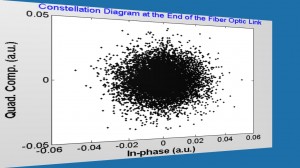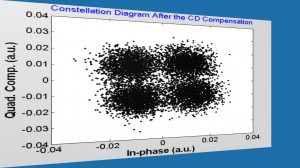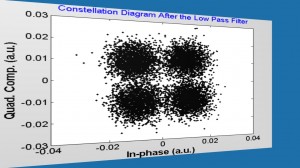OCSim Modules
Modern Fiber Optic Communication Systems Simulations with Advanced Level Matlab Modules
.
Module 11b
Digital Signal Processing
.
QPSK Fiber Optic Communication Systems with Chromatic Dispersion Compensation through
Digital Signal Processing
Company Researchers & Developers
Integrate the Modules with your in-house and Commercial Software & Hardware Products
(1) Use the Existing Modules / Components for Your Research & Development.
(2) Modify the Modules / Components to the Next Level for Your Research & Development.
(3) Integrate Different Modules / Components in the OCSim Package to Realize Your Own Fiber Optic Communication Systems.
(4) Modify the Modules for Co-Simulations with the Third Party Commercial Optical Communication Systems Softwares.
Main Module
fiber_prop_CD_comp.m
Compensation of fiber chromatic dispersion in a coherent QPSK system.
This Module calls the following Sub Modules and Components:
(1) phase_noise.m
This function introduces laser phase noise as a Wiener process. Laser linewidth should be provided.
(2) up_sample.m
This function introduces the same phase over the entire symbol interval.
(3) fiber_prop.m
This function describes the fiber propagation.
(4) amp.m
This function describes optical amplifier.
(5) down_sample_CD.m
This function does down-sampling with number of sample per symbol = down_sample_factor. For example, if down_sample_factor = 4, it means the number of samples per symbol at the receiver after down-sampling = 4.
(6) CD_comp.m
This function provides CD compensation in digital domain.
(7) ph_noise_comp_viterbi.m
This function compensates for phase noise using Viterbi-Viterbi algorithm.
Explore Further this Module:
11b.1 Turn off the laser phase noise (by setting the line widths of transmitter laser and LO to zero) and observe the constellation diagrams. Compare this with the constellation diagram when the linewidths are non-zero.
11b.2 Introduce the phase noise compensator (ph_noise_comp_viterbi.m) when the laser linewidth ranges from 100 kHz to 1MHz and observe the constellation diagrams before and after the phase compensation and CD compensation blocks.
11b.3 Increase the number of spans to 20 and calculate the number of taps required. Observe the constellation diagram before and after the CD compensation.
11b.4 Design and simulate following coherent QPSK fiber optic system links with digital signal processing:
28 GBaud, 20 span coherent QPSK fiber optic system link
10 GBaud, 60 span coherent QPSK fiber optic system link
28 GBaud, 20 span Nyquist pulse coherent QPSK fiber optic system link
10 GBaud, 60 span Nyquist pulse coherent QPSK fiber optic system link
– – –
– – –
n GBaud, N span coherent QPSK fiber optic system link
n GBaud, N span Nyquist pulse coherent QPSK fiber optic system link
Choose the desired values of n and N for simulations.
Simulate more:
Modify to DP-QPSK optical Communication systems. Scientific and Programing support is available for modifying to DP-QPSK optical systems.
.
.
Selected Simulated Results Using this Module
.

Constellation Diagram at the Transmitter
Constellation Diagram at the End of the Fiber Optic Link
Constellation Diagram After the CD Compensation
Constellation Diagram After the SPM Compensation
Constellation Diagram After the Low Pass Filter
.
.
.
OCSim Modules details can be seen by clicking the pages below:
OCSim Modules Overview | OCSim Modules (1-18) in the Package
Module (1a) | Module (1b) | Module (1c) | Module (2a) | Module (2b) | Module (2c) | Module (3a) | Module (3b) | Module (4a) | Module (4b) | Module (4c) | Module (4d) | Module (5) | Module (6a) | Module (6b) | Module (7) | Module (8a) | Module (8b) | Module (8c) | Module (9a) | Module (9b) | Module (10) | Module (11a) | Module (11b) | Module (12) | Module (13) | Module (14) | Module (15) | Module (16) | Module (17) | Module (18)
.
OCSim Modules Brochure | OCSim Modules Selected Publication References | OCSim Modules Application Examples |
OCSim Modules Selected Simulated Results | OCSim Modules Videos
.
Contact Us: Headquarter: Ottawa, Canada covering USA and Europe, Distributors: South America, Japan, India, Australia, China, South Korea.



